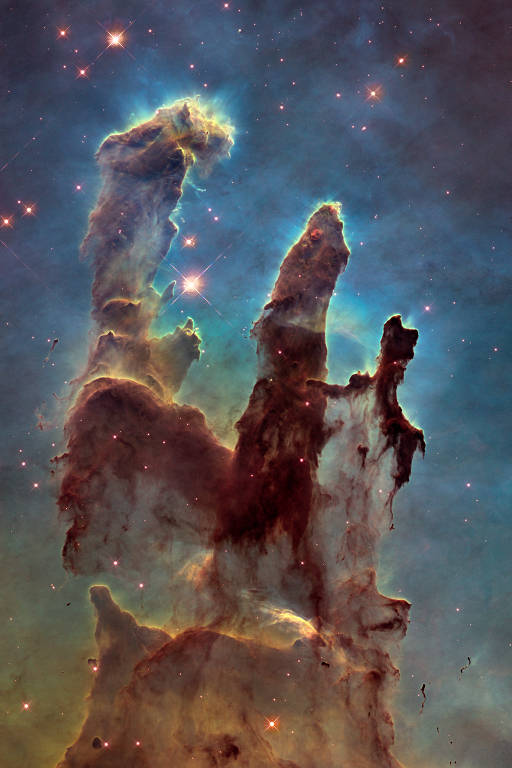The James Webb Space Telescope has captured the iconic “Pillars of Creation”, massive structures of gas and dust filled with stars – an image as “majestic” as could be expected, NASA said on Wednesday. .
The “Pillars of Creation” are located 6,500 light-years from Earth, in the Eagle Nebula of the Earth’s galaxy, the Milky Way.
The twinkling of thousands of stars illuminates the James Webb telescope’s first photo of these gigantic brown and orange columns towering in the middle of the cosmos.
The ‘Pillars of Creation’

The ‘Pillars of Creation’ are huge structures of gas and dust filled with stars 6,500 light-years from Earth. On the left, the highest resolution image from the James Webb Space Telescope’s infrared camera. On the right, the last image captured by the Hubble Telescope in 2020 – NASA/ESA/CSA/AFP
At the ends of several pillars are bright red spots that look like lava.
“These are ejections from stars that are still forming,” just a few hundred thousand years old, the US space agency said in a statement.
These “young stars periodically launch supersonic jets that collide with clouds of material, like these thick pillars,” he explained.
The “Pillars of Creation” became famous thanks to the Hubble Space Telescope, which first captured them in 1995 and later in 2014.
Now, with the infrared capabilities of James Webb, the world’s most powerful and modern telescope launched into space less than a year ago, one can see through the opacity of the pillars, revealing the formation of many new stars.
“At popular demand, we had to do the Pillars of Creation” with James Webb, tweeted today Klaus Pontoppidan, science program manager at the Space Telescope Science Institute (STScI), which operates Baltimore’s Webb.
“There are so many stars!” he added.
In a tweet, NASA astrophysicist Amber Straughn summed it up: “The universe is beautiful!”
The image, which covers an area of about eight light-years, was taken by Webb’s NIRCam imager, which captures near-infrared wavelengths invisible to the human eye. The image colors were “translated” into visible light.
According to NASA, the new image “will help researchers renew their models of star formation by identifying much more accurate counts of newly formed stars, along with the amounts of gas and dust in the region.”
In operation since July, the James Webb is making its observations 1.5 million kilometers from Earth. One of the main goals of this $10 billion telescope is to study the life cycle of stars. Another main line of investigation is the study of exoplanets, that is, planets outside the Earth’s solar system.
I am Janice Wiggins, and I am an author at News Bulletin 247, and I mostly cover economy news. I have a lot of experience in this field, and I know how to get the information that people need. I am a very reliable source, and I always make sure that my readers can trust me.










